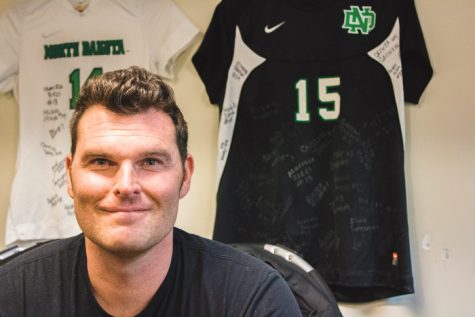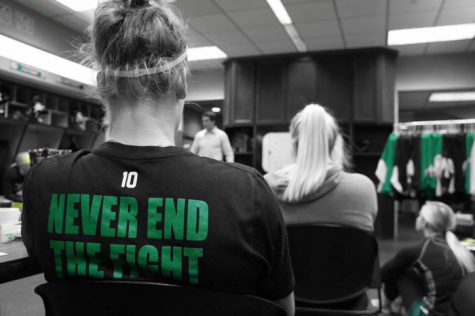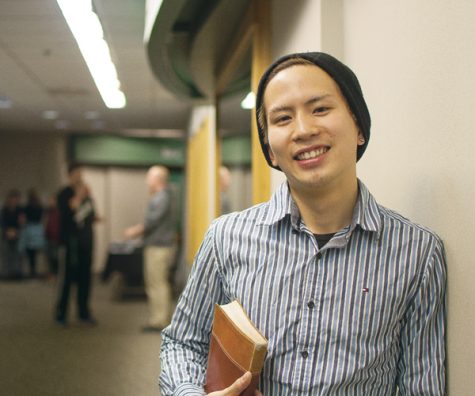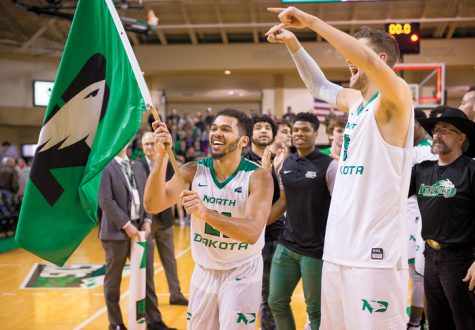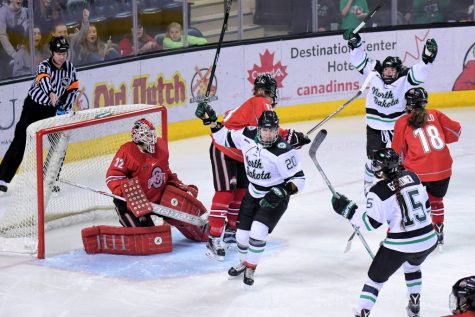Fifteen years in the making
March 24, 2017
In a season full of ups and downs, the Fighting Hawks are heading to their 32nd NCAA tournament behind strong play down the stretch resulting in a 4-3 NCHC championship loss to Minnesota-Duluth last Saturday.
While ending on a losing note, the Fighting Hawks (21-15-3, NCHC 11-12-1) boosted their ranking in the Pairwise to no. 10, which was enough for an at-large bid as the no. 3 seed in the West Regional this weekend. They will be matched up with Boston University, who is making its 35th tournament appearance.
A couple of weeks ago the tournament was no guarantee for the Hawks, but after winning five of their last six games, including the NCHC semifinal to no. 1 Denver, they played their way in.
More impressively, UND will be making its 15th straight NCAA tournament appearance. The streak is the second-longest in NCAA Division I Men’s Hockey history, only trailing Michigan, who put together 22 straight appearances from 1991-2012. Currently, the next best streak belongs to Denver, who will be making their ninth straight appearance this weekend.
During UND’s streak, they have eight Frozen Four appearances, two championship appearances and one championship title, showing that UND has not just made it to the tournament, but also had success in it.
That kind of long lasting success is unique not only in college hockey, but in college sports, when you take into account how teams change year-to-year. With the trend of top college athletes leaving early for the pros, along with coaching resignations and graduating seniors, it can present challenges for schools to maintain success.
Yet, in the case of UND, they have endured through star players leaving for graduation or the pros and have continued to win with three different head coaches, overcoming obstacles like no other team has been able to do in the last 15 years.
So, how have they done it? What’s their recipe for success?
Well, let’s look into the ingredients. Although, I will be the first to admit that I have not mastered the recipe.
Coaching Stability
Obviously, coaching is key to maintaining long-term success.
Looking back to Michigan’s 22-year tournament run, they had coaching stability throughout, as Red Berenson headed the team in each of those seasons. Often times, this is the case for teams that go on successful runs. Just ask the New England Patriots who have won eight straight division titles, resulting in eight playoff appearances and two Super Bowl championships under head coach Bill Belichick.
Unlike Michigan and the Patriots though, UND has not had the stability at the head coaching position in their run of 15 straight NCAA tournament appearances, as they have had three head coaches throughout that time in Dean Blais, Dave Hakstol and currently, Brad Berry.
For many teams, successful runs under multiple coaches are unheard of, especially since coaching transitions tend to take at least a season. For example, highly successful head coach Don Lucia led Minnesota to a mediocre 20-19-2 in his first season as coach before making the NCAA tournament in his second season. To a larger extreme, Michigan’s Berenson headed his team to three losing seasons to start his tenure and did not reach an NCAA tournament until his seventh season.
Yet, with both UND coaching transitions, Hakstol and Berry have continued to lead UND to winning seasons resulting in tournament appearances. In fact, Hakstol took his first UND squad to an NCAA championship, albeit in a 1-4 losing effort to Denver, while Berry became the first collegiate hockey coach to win a national championship in his first season.
On the surface, it’s rather amazing to see how the coaching changes have worked so smoothly for UND, but each has a distinct difference from many other coaching changes. Instead of betting on successful free agent coaches or the next “hot shot” coach to lead UND, they have relied on hiring within the program.
Looking at UND’s last three coaches, each spent multiple seasons as an assistant coach at UND. Blais spent nine seasons under UND coaching legend Gino Gasparini, Hakstol spent four under Blais, and Berry spent nine under Blais and Hakstol. Additionally, coach Dane Jackson has been with the club for eleven seasons as an assistant and associate head coach.
Of course, it has helped that Blais and Hakstol left the team for the NHL under good conditions for the next coach. Nevertheless, hiring head coaches within has allowed UND to maintain stability in their leadership, vision and culture, translating to winning seasons and NCAA tournament appearances.
Goalie development & play
While UND has had its share of gifted forwards and defensemen over the years, the most important position over the last 15 seasons has arguably been the goaltending.
Back in 2001-02, the season before UND went on its 15-year run of tournament appearances, the goalies posted a goals against average of 3.6. Although UND averaged a respectable 3.6 goals a game that season, the poor defensive play and goaltending was too much to overcome as they headed to a 16-19-2 finish.
Since then, goalie play has drastically improved, as goalies have not surpassed a 2.74 goals against average in a season. Last season’s goalie tandem of Cam Johnson and Matt Hrynkiw combined for a 1.82 goals against average, which stands as the lowest average in the 15-year stretch and carried the team to its first national title since 2000.
Additionally, except for 2012-13 starting goalie Clarke Saunders, all other starting goalies have taken a majority of starts in at least two seasons. Furthermore, Brad Eidsness is the only UND goalie to start a majority of games in his freshman season, showing that UND has leaned on experience at the position to carry them to productive seasons.
As far as NCAA tournament success goes, seasons where goalies had a goals against average of 2.5 or above made the Frozen Four in one of four seasons. For seasons where the goals against average was below 2.5, UND has made the Frozen Four in seven of 10, showing the importance of goalie play.
Currently, UND’s goalies this season combine for a 2.54 goals against average, which has been good enough to get into the tournament, but time will tell if the goalie play will be enough to go deep into the tournament.
Development of professional talent
Recruiting could easily be the subline here, but why has UND attracted the best talent in the country?
Sure, there are many reasons, but one that is highly attractive for recruits is the fact UND has a history of developing players that not only make it to the NHL, but succeed there as well.
According to an article on NCAA.com, UND had nine players on NHL playoff rosters last season, which was second among college programs. In total, they have had 171 players drafted into the NHL, including 10 on this season’s roster.
UND has also had one player elected into the NHL Hall of Fame in goalie Ed Balfour, who had an 18-year career, resulting in 500 wins, six All-Star Games, two Vezina trophies and one Stanley cup.
More recently, UND has developed star players in Jonathan Toews, Matt Greene, Zach Parise, T.J. Oshie, Travis Zajac and Drew Stafford. In addition, Troy Stecher, Nick Schmaltz and Drake Caggiula have enjoyed strong rookie seasons with NHL clubs this season with the former having three goals and 18 assists in 20 minutes and 22 seconds per game.
Essentially, UND’s ability to develop successful NHL players has allowed the Hawks to reload their roster year after year with top-end talent. Yet, if UND did not have a track record of good NHL players, there is an argument that there tournament streak would have ended long ago.
Ralph Engelstad Arena
Ralph Engelstad Arena became the new home for UND in 2001-02 and has arguably become the greatest home ice advantage in college hockey.
In their first year at REA, they posted a 7-9-1 record, but have had a winning record at home ever since. That means UND has 15 straight winning seasons at home to go along with 15 straight tournament appearances.
In total, UND has a 218-82-37 record at REA and prior to this season, has averaged 11,356 fans game. In the last five seasons, UND has had the highest attendance in college hockey.
Essentially, UND’s ability to play well at home has translated into overall success, especially considering their road records have tended to be worse, albeit still solid. It also makes for another huge selling point to recruits looking to play in one of the best hockey environments in the country.
Moving Forward
While this season’s Hawks squad has benefited from each of these areas, there is one area that is a cause for concern about this year’s squad. Goaltending.
As pointed out earlier, the goaltending numbers have been on the high side compared to other seasons within UND’s 15-year streak and only one of the prior four teams that has had a goals against average of over 2.5 reached the Frozen Four.
That being said, this season’s team compares most to the team that made it to the Frozen Four in 2006-07. Along with both squads carrying goals against averages of over 2.5, both have young rosters with the current team carrying 17 freshmen and sophomores compared to 19 in 2006. In addition, both won five of seven games to close out the regular season and conference playoff in order to play their way into the NCAA tournament after tough stretches in the early to mid portions of their respective seasons.
With that in mind, I am picking UND to defy the odds and come out of the West Regional, as they have shown improvement down the stretch.
Specifically, I have them taking out Boston University in the regional semifinal and Minnesota-Duluth in the regional final. As they head to a fourth consecutive Frozen Four, UND’s fate will end like the 2006-07 squad, as they will lose in the semifinal to Harvard.
Nevertheless, there is much to be proud of at UND, as for a 15th straight year, the UND Fighting Hawks give themselves a chance to win another national title.
Jake Andersen is a staff writer for Dakota Student. He can be reached at [email protected]



